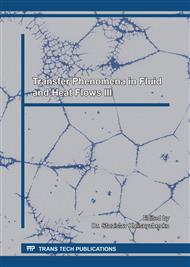[1]
L. Wang, B. Sunden, Experimental investigation of local heat transfer in a square duct with various shaped ribs, Heat Mass Transfer 43 (2007) 759-766.
DOI: 10.1007/s00231-006-0190-y
Google Scholar
[2]
G. Tanda, Heat transfer in rectangular channels with transverse and V-shape broken ribs, International Journal of Heat Mass Transfer 47 (2004) 229-243.
DOI: 10.1016/s0017-9310(03)00414-9
Google Scholar
[3]
T. Salameh, B. Sunden, An experimental study of heat transfer and pressure drop on the bend surface of a U-duct, ASME Paper GT2010-22139 (2010) 9 pages.
DOI: 10.1115/gt2010-22139
Google Scholar
[4]
V. Srinath Ekkad, J.C. Han, Detailed heat transfer distributions in two-pass square channels with rib turbulators, International Journal of Heat Mass Transfer 40 (1997) 2525-2537.
DOI: 10.1016/s0017-9310(96)00318-3
Google Scholar
[5]
A. Lanjewar, J.L. Bhagoria, R.M. Sarviya, Heat transfer and friction in solar air heater duct with W-shaped rib roughness on absorber plate, Energy 36 (2011) 4531-4541.
DOI: 10.1016/j.energy.2011.03.054
Google Scholar
[6]
J.C. Han, J.S. Park, Developing heat transfer in rectangular channels with rib turbulators, International Journal of Heat Mass Transfer 31 (1988) 183-195.
DOI: 10.1016/0017-9310(88)90235-9
Google Scholar
[7]
R. Chandra, C.R. Alexander, J.C. Han, Heat transfer and friction behaviors in rectangular channels with varying number of ribbed walls, International Journal of Heat Mass Transfer 46 (2003) 481-495.
DOI: 10.1016/s0017-9310(02)00297-1
Google Scholar
[8]
A. Haasenritter, M. Amro, B. Weigand, An experimental and numerical study of the transfer performance of sharp-edged and rounded ribs in square ducts, Proceedings of the 9th International Symposium on Transport Phenomena and Dynamics of Rotating Machinery, Honolulu, Hawaii, USA (2002).
Google Scholar
[9]
M.E. Taslim, H. Liu, A combined numerical and experimental study of heat transfer in roughened square channel with 45o ribs, International Journal of Rotating Machinery 1 (2005) 60-66.
DOI: 10.1155/ijrm.2005.60
Google Scholar
[10]
A. Chaube, P.K. Sahoo, S.C. Solanki, Analysis of heat transfer augmentation and flow characteristics due to rib roughness over absorber plate of a solar air heater, Renewable Energy 31 (2006) 317-331.
DOI: 10.1016/j.renene.2005.01.012
Google Scholar
[11]
A. Kamali, A.R. Binesh, The importance of rib shape effects on the local heat transfer and flow friction characteristics of a square ducts with ribbed internal surfaces, International Communications in Heat Mass Transfer 35 (2008) 1032-1040.
DOI: 10.1016/j.icheatmasstransfer.2008.04.012
Google Scholar
[12]
B. Lu, P.X. Jiang, Experimental and numerical investigation of convection heat transfer in a rectangular channel with angled ribs, Experimental Thermal Fluid Science 30 (2006) 513-521.
DOI: 10.1016/j.expthermflusci.2005.09.007
Google Scholar
[13]
L. Shui, J. Gao, L. Xu, X. Wang, Numerical investigation of heat transfer and flow characteristics in a steam-cooled square ribbed duct, ASME paper GT2010-22407 (2010) 10 pages.
DOI: 10.1115/gt2010-22407
Google Scholar
[14]
A. Kashmiri, M.A. Cotton, Y. Addad, Numerical simulations of flow and heat transfer over rib-roughened surfaces, Proceedings of the 17th Annual Conference of CFD Society of Canada, Ottawa (2009) 8 pages.
Google Scholar
[15]
G.J. Poitras, B. Laurent Emmanuel, G. Yves, Structure of channel flows with surface mounted ribs, Journal of Thermal Science 13 (2004) 214-219.
Google Scholar
[16]
Somchai Sripattanapipat, Pongjet Promvonge, Numerical analysis of laminar heat transfer in a channel with diamond-shaped baffles, International Communications in Heat and Mass Transfer 36 (2009) 32-38.
DOI: 10.1016/j.icheatmasstransfer.2008.09.008
Google Scholar
[17]
E. Sparrow, M. Charmchi, Heat transfer and fluid flow characteristics of span-wise periodic corrugated ducts, International Journal of Heat Mass Transfer 23 (1980) 471-481.
DOI: 10.1016/0017-9310(80)90089-7
Google Scholar
[18]
Fifi N.M. Elwekeel, Antar M.M. Abdala, Qun Zheng, Numerical investigation of heat transfer coefficient in ribbed rectangular duct with various shaped ribs and different coolants, Proceedings of International Conference on Mechanical Engineering and Material Science (2012).
DOI: 10.2991/mems.2012.119
Google Scholar
[19]
Andallib Tariq, S.K. Swain, P.K. Panigrahi, An experimental study of convective heat transfer from flat and ribbed surfaces, Indian Journal of Engineering and Material Sciences 9 (2002) 464-471.
Google Scholar
[20]
Tang Xinyi, Zhu Dongsheng, Experimental and numerical study on heat transfer enhancement of a rectangular channel with discontinuous crossed ribs and grooves, Chinese Journal of Chemical Engineering 20(2) (2012) 220-230.
DOI: 10.1016/s1004-9541(12)60382-6
Google Scholar
[21]
Ali Najah Al-Shamani, K. Sopian, H.A. Mohammed, Sohif Mat, Mohd Hafidz Ruslan, Azher M. Abed, Heat and flow characteristics of air heater ducts provided with turbulators, Case Studies in Thermal Engineering 5 (2015) 48-58.
DOI: 10.1016/j.csite.2014.12.003
Google Scholar
[22]
A. Dewan, P. Mahanta, K. Sumithra Raju, P. Suresh Kumar, Review of passive heat transfer augmentation techniques, Proc. Instn. Mech. Engrs. Part A: J. Power and Energy 218 (2004) 509-527.
DOI: 10.1243/0957650042456953
Google Scholar
[23]
Mohsen Sheikholeslami, Mofid Gorji-Bandpy, Davood Domiri Ganji, Review of heat transfer enhancement methods: focus on passive methods using swirl flow devices, Renewable and Sustainable Energy Reviews 49 (2015) 444-469.
DOI: 10.1016/j.rser.2015.04.113
Google Scholar
[24]
Tabish Alam, R.P. Saini, J.S. Saini, Heat and flow characteristics of air heater ducts provided with turbulators – a review, Renewable and Sustainable Energy Reviews 31 (2014) 289-304.
DOI: 10.1016/j.rser.2013.11.050
Google Scholar
[25]
Tabish Alam, R.P. Saini, J.S. Saini, Use of turbulators for heat transfer augmentation in an air duct - a review, Renewable Energy 62 (2014) 689-715.
DOI: 10.1016/j.renene.2013.08.024
Google Scholar


